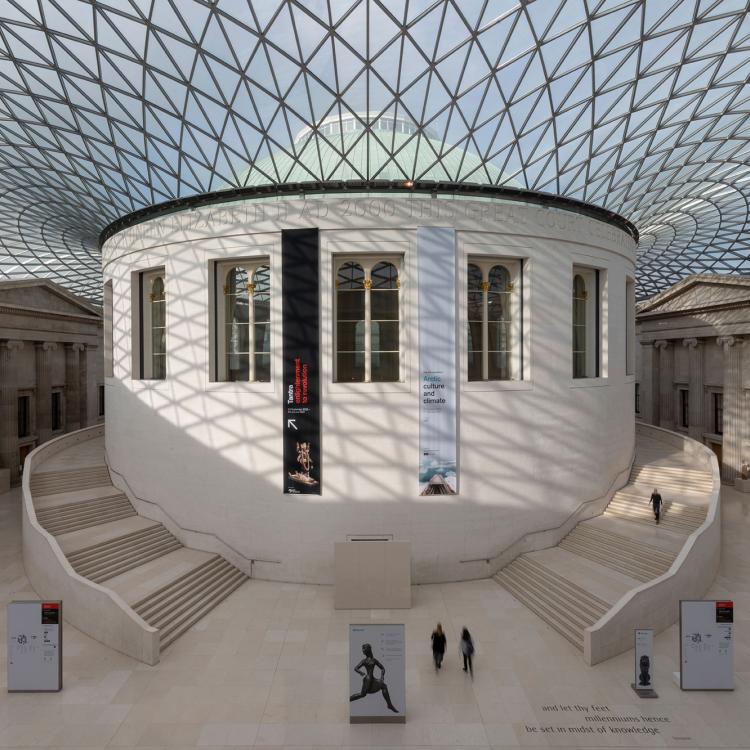The Great Court
At the centre of the British Museum sits the largest covered public square in Europe, the Queen Elizabeth II Great Court.
Designed by Foster and Partners, the Great Court is a two-acre space enclosed by a spectacular glass roof with the world-famous Reading Room in the middle.
The 6 December 2020 marked 20 years since the redesigned Great Court was opened. In that time, 113 million people have walked under the glass roof.
A place for all
Free and open every day to visitors, the Great Court is one of London's most unique spaces.
In the original Robert Smirke Great Court design, the courtyard was supposed to be a garden. However, from 1852 many bookstacks were built, and along with the Reading Room it became the home of the library department of the Museum.
The department stayed in the Great Court until 1997, when it was relocated to the new British Library building in St Pancras. Now empty, the Museum took the opportunity to once again reopen the space to the public.
The redesign
The new Millennium
An architectural competition to redesign the courtyard space was launched with three aims: reveal hidden spaces, revise old spaces and create new spaces. With more than 130 entries, the eventual winner was Foster and Partners.
The £100 million project was supported by grants of £30 million from the Millennium Commission and £15.75 million from the Heritage Lottery Fund.
Queen Elizabeth II
The Great Court will benefit the millions of people who come to the British Museum every year. We can be confident that it will become a landmark associated with the new millennium.
Queen Elizabeth II
The courtyard
Redesigning the Great Court
The redesign of the Great Court allowed the previously hidden space to be seen once again, no longer lost to the general public.
Loosely based on Norman Foster's concept for the roof of the Reichstag in Berlin, a key aspect of the design was that with every step in the Great Court the vista changed giving the visitor a new surrounding.
Work on the Great Court's magnificent glass and steel roof – made from 3,212 panes of glass (no two of which are the same) – began in September 1999.
The Great Court was opened on 6 December 2000 by Queen Elizabeth II.
On completion, the redesign grew the Museum by 40 per cent. For the first time in more than 150 years, the new two-acre Great Court gave visitors the chance to move freely around the main floor of the Museum.
Hartwig quote
This spectacular glass-roofed courtyard has welcomed 113 million people since the turn of the Millennium, and it is the glorious starting point for nearly every visitor.
Hartwig Fischer, Former Director of the British Museum (2016–2023)
Creating new spaces
The redesign of the Great Court also provided two new gallery spaces. The Sainsbury Galleries housing a display of objects from the Museum's Africa collection.
Plus the Wellcome Trust Gallery, home to a series of long-term, cross-cultural, thematic exhibitions, currently based around Living and Dying.
A new space was also built for temporary exhibitions, Room 35 – The Joseph Hotung Great Court Gallery.
Along with the ground floor, the redesign transformed the lower level of the Great Court too.
Educational facilities
Housed on the lower level of the Great Court is the Clore Centre for Education, a space that has enabled the Museum to expand its educational role. It includes the:
- BP Lecture Theatre
- Hugh and Catherine Stevenson Theatre
- Rooms A and B
- Studio – used for art and craft activities
- Claus Moser seminar room
- Ford Centre for Young Visitors
- Samsung Digital Discovery Centre
Its two auditoriums are home to a daily programme of lectures, film and videos, as well as conferences, concerts and other performances related to cultural festivals or special exhibitions.
Five additional multi-purpose rooms are also used for other programmes ranging from informal 'drop-in' sessions to courses for the general public and teacher training.
The Ford Centre for Young Visitors
What was previously a storage room for Egyptian sculpture became the Ford Centre for Young Visitors.
Today, this space provides dedicated facilities and a range of tailor-made educational programmes for hundreds of thousands of young people who visit the Museum every year.
At weekends and during school holidays this area is used for family and community events.
Visitor facilities
The new space allowed for the construction of new facilities including the Great Court Restaurant on the upper level and the Court Cafés on the ground level of the Great Court.











